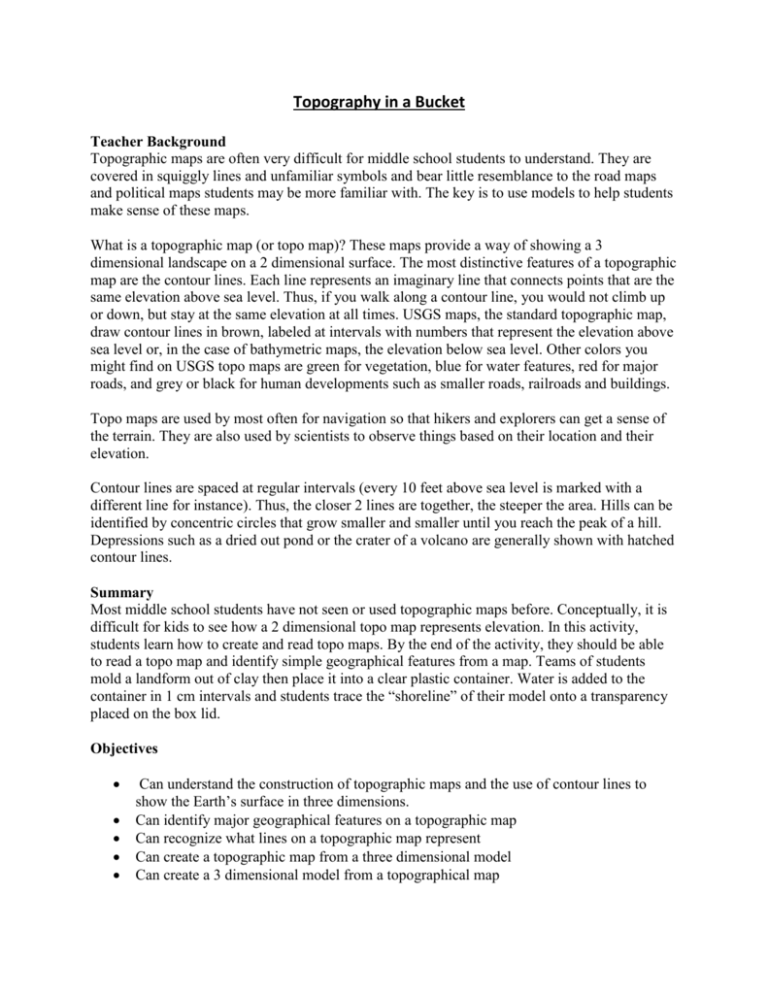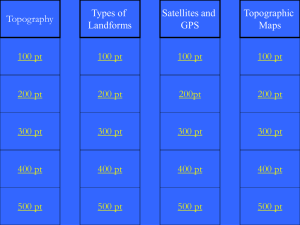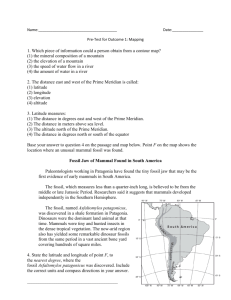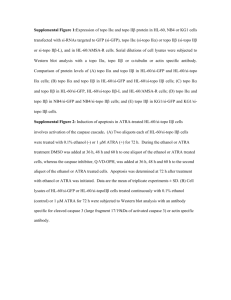Topography in a Bucket
advertisement

Topography in a Bucket Teacher Background Topographic maps are often very difficult for middle school students to understand. They are covered in squiggly lines and unfamiliar symbols and bear little resemblance to the road maps and political maps students may be more familiar with. The key is to use models to help students make sense of these maps. What is a topographic map (or topo map)? These maps provide a way of showing a 3 dimensional landscape on a 2 dimensional surface. The most distinctive features of a topographic map are the contour lines. Each line represents an imaginary line that connects points that are the same elevation above sea level. Thus, if you walk along a contour line, you would not climb up or down, but stay at the same elevation at all times. USGS maps, the standard topographic map, draw contour lines in brown, labeled at intervals with numbers that represent the elevation above sea level or, in the case of bathymetric maps, the elevation below sea level. Other colors you might find on USGS topo maps are green for vegetation, blue for water features, red for major roads, and grey or black for human developments such as smaller roads, railroads and buildings. Topo maps are used by most often for navigation so that hikers and explorers can get a sense of the terrain. They are also used by scientists to observe things based on their location and their elevation. Contour lines are spaced at regular intervals (every 10 feet above sea level is marked with a different line for instance). Thus, the closer 2 lines are together, the steeper the area. Hills can be identified by concentric circles that grow smaller and smaller until you reach the peak of a hill. Depressions such as a dried out pond or the crater of a volcano are generally shown with hatched contour lines. Summary Most middle school students have not seen or used topographic maps before. Conceptually, it is difficult for kids to see how a 2 dimensional topo map represents elevation. In this activity, students learn how to create and read topo maps. By the end of the activity, they should be able to read a topo map and identify simple geographical features from a map. Teams of students mold a landform out of clay then place it into a clear plastic container. Water is added to the container in 1 cm intervals and students trace the “shoreline” of their model onto a transparency placed on the box lid. Objectives Can understand the construction of topographic maps and the use of contour lines to show the Earth’s surface in three dimensions. Can identify major geographical features on a topographic map Can recognize what lines on a topographic map represent Can create a topographic map from a three dimensional model Can create a 3 dimensional model from a topographical map Vocabulary Elevation Contour line Topographic map Logistics Time: 135-150 minutes (approximately 3 class periods) Grouping: Teams of 2-4 students. I found this activity works best with groups of 3. Students stay engaged and can get access to materials, but as a teacher, you don’t need to provide as many sets of materials with groups of 2. Materials: several example topographic maps for students to examine before they begin optional (though highly recommended) – raised relief map of state or local area (Tuzigoot National Monument has raised relief maps for sale and provides a discount for teachers) For the clay model each group needs 1 fist-sized lump of synthetic Plasticine clay (Play-Doh will work, however, it is somewhat water-soluble and therefore becomes slimy after the water box step.) 1 small bead of clay of a different color (for marking the top of the mountain) 1 sheet of transparency film (the sheet of transparency needs to fit on top of the plastic container below) For making the topo map from the model each group needs 1 1 full-sheet of transparency film fine-tip Sharpie or overhead marking pen (Permanent pens won’t smudge if a drop of water gets on their map. On the other hand, students can’t make corrections if they make a mistake.) 1 plastic shoebox-sized container, at least 8 cm (3 inches) tall. 1 flat, transparent lid for the plastic container (Most plastic storage containers come with textured, opaque lids. You need something like a sheet a clear Plexiglas that can sit over the top of the box and which students can write on. I recently discovered these plastic salad boxes provide a container and a lid in one!) access to a pitcher of water with 4 drops blue food coloring (I had 2 teams share 1 pitcher) 1 plastic ruler Lesson Plan Introduction and Making Clay Models 1. Tell students that when we study watersheds it is useful to know how the land dips and rises – where the hills, valleys, ridges, stream beds, and plains are. Most maps don’t tell us this information. They may show cities, roads, and rivers, but not valleys, ridges, and mountains. Tell students that there is a special type of map called a topographic map that does show how the land rises and falls. 2. Give students copies of various topo maps. Ask them what they notice. Have them trace a contour line and tell them what a contour line is. Have them notice how some lines are labeled with the elevation. Have them look for hills by finding concentric circles. Have them look for steep places by finding lots of lines close together and look for flat places by finding lines spaced very far apart. If you have a raised relief map available, help students draw comparisons between the two and see a relationship between these two types of maps. Their understanding will be, and should be, very superficial at this point. 3. Tell students that over the next few days they will be making a model clay island, making a topo map of their island, giving their topo map to another group, and that other group will try to recreate their island using clay or other materials. Divide students into groups. 4. Give each student their first set of materials for making clay models and give them rules for their islands: o islands should fit on their transparency o islands should have high and low regions such as mountains and valleys o islands should not have extremely steep cliffs or overhangs o islands should not be too complicated o on the highest point of the island, place an “x” using the other color of clay 5. Give students 15-20 minutes to make their islands. Circulate among them making sure they are following the rules. Groups that finish early can add features such as a peninsula near the water, a stream coming down the mountainside, etc. Making a Topo Map of the Model 1. Using one of your students’ clay models, demonstrate the procedure for making the topo map. 2. Use the marker to label North, South, East and West on the transparency below the clay model. 3. Label the compass points on the large sheet of transparency as well. 4. Place the clay model in the bottom of the plastic container. 5. Place the lid over the container with the transparency on top, oriented the same way (according to the compass points) as the clay model below. 6. Holding your head very still above the lid, trace the shoreline of the island onto the transparency using the marker. Also trace the cross at the top of the tallest hill. This cross will be a reference point to help figure out where to put your head. 7. Remove the lid. Holding a ruler inside the container near the base of the island, pour blue water into the container until the water is 1 cm deep. Notice how the water creates an imaginary line where the elevation above “sea level” is 1 cm all the way around. 8. Replace the lid and the transparency, making sure the transparency is oriented correctly. Match the first coastline and the cross to the island below. 9. Again, holding your head very still, trace the new shoreline of the island – where the water level touches the model. (You can probably end the demonstration here. Students should continue onto the next step.) 10. Repeat adding water and tracing new contour lines until the island is completely submerged. 11. Give students the second set of materials. My students needed 30-45 minutes to create their maps. 12. When all the students are finished, you can assess their understanding so far by placing all the models up at the front of the room and collecting all the maps. Place a map on the overhead projector and look at its features. See if students can tell which model it belongs to. Use features such as the number of hills, distinctive coastlines, valleys, etc. to help students identify which model goes with which map. Assessment 1. Give students a simplified topo map similar to the ones they made and ask them to predict what it would look like in 3 dimensions. Ask them to identify different features: the tallest hill, the steepest part, the flattest part, the elevation of various points, streams, etc. Sources Activity descriptions and ideas I first learned how to make topo maps from Eric Muller of the Exploratorium’s Teacher Institute. I changed the method for making the topo map from the models but otherwise our activities are very similar. You can download his "To Topo Two" activity from his website with other stellar activities. USGS has a great description of how to make 3-D model using clear, stacking, salad tray tops. If you are an NSTA member, Science Scope had a fabulous article in its October 2005 issue called “Making Sense of Topographic Maps”. Topographic map information The best place to learn more about topographic maps is the USGS. For more information about the symbols commonly found on topo maps, see the USGS map symbols page. For more information about how topo maps are created and what they are, see the USGS topo map information page.







